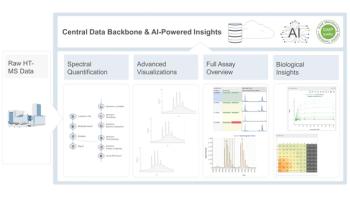
- Special Issues-10-09-2020
- Volume 33
- Issue 10
Physicochemical Methods for Vectors and Ancillary Materials in Cellular and Gene Therapies
Cellular and gene therapies (CGTs) have contributed significantly to the improvement of clinical outcomes for patients in the recent years. This paper discusses a range of physicochemical methods that play an important role in the difficult characterization of viral vectors, to meet the unique needs of CGT manufacturing process development, process and product characterization, and the quality control testing of these materials.
Cellular and gene therapies (CGTs) have contributed significantly to the improvement of clinical outcomes for patients in the recent years. As a result of their complexity and the nascent state of the field, the characterization of viral vectors and ancillary materials is challenging. In this review, the authors present a suite of physicochemical methods that play an important role in the characterization of viral vectors, including adeno-associated virus, lentiviral vector, and ancillary materials. These physicochemical methods are positioned to meet the unique needs of CGT manufacturing process development, process and product characterization, and the quality control testing of these materials.
Cellular and gene therapies (CGTs) are a rapidly growing sector because of their impressive efficacies in a range of diseases (1). Gene therapy offers patients the promise of one single treatment for a lifelong genetic disease. The efficacy of chimeric antigen receptor (CAR) T cell therapies have been remarkable for hematological malignancies. CGT manufacturing is complex and employs a wide range of critical raw materials and reagents. For example, a CAR-T manufacturing process (Figure 1) requires selection and activation reagents, cell culture media, cytokines, vectors for gene transfer, ribonucleoprotein for gene editing, and formulation buffer at several different process steps.
Vectors are critical components of cellular therapies as they deliver the genetic material to the target cells. The most common viral vectors used in gene and cell therapy are lentiviral vectors (LVV) and adeno-associated virus (AAV). USP <1043> defines the quality requirement for ancillary materials for gene and cellular therapies. Detailed characterization of all ancillary material used in vector production such as plasmids, cell culture media, or host cell line is considered necessary. Characterization of CGT vectors and ancillary materials requires multiple physicochemical techniques. Table 1 provides an overview of the applications of typical physicochemical methods in CGT development and manufacturing. Each technique is described in more detail in the following sections.
Chromatography
Analytical chromatography is well established for protein and small molecule analysis because of its high resolution and ease of operation. The different modes of chromatography work well for proteins but cannot be applied to cellular drug products. The direct application of chromatography to lentiviral vector analysis is challenging due to the size and complexity of LVV. Nevertheless, chromatography can be used for AAV and other ancillary materials used in the manufacturing process. In the examples below, chromatography has been applied to resolve AAV product-related impurities, purification of lentivector, and gene-editing materials such as single guide ribonucleic acid RNA (sgRNA) and its impurities.
Ion exchange chromatography (IEC) has demonstrated the ability to resolve full AAV particles from empty AAV particles, because full particles carry DNA that contain more negative charges (2,3). Since empty AAV could negatively impact cell transduction, the ratio of empty‑to-full particles is a critical quality attribute that needs to be monitored and controlled. In these studies, monolith columns can resolve the AAV variants and allow fast mass transfer. It is interesting to note that adding 2-mM MgCl2 could improve the peak shape and reduce the non‑specific interaction between AAV and the resin (2). Utilizing the native fluorescence of the capsid proteins, the detection limit could be improved from 1011 vg/mL (vector genome per milliliter) with UV detection to 1010 vg/mL. The method run time is around 30 min and has a higher throughput compared with analytical ultracentrifugation (AUC). The IEC method has been qualified and demonstrates method performance suitable for quality control testing (2). We should note IEC has some limitations when discriminating fragment capsids versus full/empty capsids and additional orthogonal methods are needed to fully characterize them.
Size-exclusion chromatography (SEC) has been developed as a sample preparation tool for LVV. Protein impurities can be removed during LVV sample preparation using columns, such as qEv columns, which are designed for large particles (4). The fractions separated by SEC were further characterized by tunable resistive pulse sensing technology, a single particle characterization method. By coupling the separation technique with the biophysics techniques within an integrated platform, the detailed profiling of the lentiviral vector can be obtained and support vector process development.
The purity and sequence of sgRNA is important for the clustered regularly interspace short palindromic repeats (CRISPR) gene editing technology because impurities in sgRNA can cause a potentially off-target cutting. For sgRNA close to 100 nucleotides, IEC has been shown to have a better resolution than ion pair chromatography, a common method that has been applied to oligonucleotide analysis (5). To develop the optimized method, RNA’s secondary structure and stability were considered. It has been found that the mobile phase at pH 12 could disrupt the base pairing and reduce secondary structure. At 10 °C, the on‑column degradation is negligible during the HPLC analysis time, but with an extra 15 or 30 min on the column, the peak heights slightly decrease (Figure 2). This assay could be a powerful tool to monitor the quality of sgRNA.
Capillary Electrophoresis
Capillary electrophoresis (CE) has gained wide acceptance for the characterization of biopharmaceuticals. CE is also an important quantitative tool for DNA and RNA analysis. Three representative applications of CE for AAV capsid proteins, viral particles, and plasmids are highlighted below.
AAV viral capsids are composed of three main proteins: VP1 (87kDa), VP2 (73kDa), and VP3 (61kDa) (6). The purity of the AAV viral proteins is crucial for AAV gene therapy product safety and efficacy (7). Compared to sodium dodecyl sulphate-polyacrylamide gel electrophoresis (SDS-PAGE) the well-established SDS capillary gel electrophoresis (SDS‑CGE) method used for AAV capsid protein analysis provides advantages in terms of method versatility and performance. For example, the integration of more sensitive detectors and a variety of online sample preconcentration techniques to increase sensitivity. Laser‑induced fluorescence (LIF) detection offers higher sensitivity than UV or PDA detection by a factor of greater than 100‑fold (8). The implementation of LIF with CE separation enables analysis of low concentration AAV samples. Another online sample preconcentration technique in CE to improve analytical sensitivity is field‑amplified sample stacking (9). By injecting and then concentrating samples electrokinetically, the stacking occurs concurrently at the head of the capillary during injection. The operation is simple and effective, and little sample matrix is injected. The sample stacking (Figure 3) shows improvement in signal‑to‑noise ratio compared to SDS‑CGE (10).
In addition to capsid protein analysis, CE can be used for intact AAV particle analysis in upstream and downstream samples of the AAV drug product manufacturing process. A method published in 2017 (11) showed that AAV particles can be separated from matrix components, such as cell debris, residual cell DNA, and/or proteins on a PVA-coated capillary, which enables one single method to reliably and rapidly quantify intact AAV particles throughout the full process. The results obtained from the CE method and qPCR showed equivalency, with the CE fast run times resulted in an overall time‑to-result of less than 4 hours for 30 samples compared to 3 days by qPCR. Moreover, the precision and accuracy were also improved: CE method showed precision on AAV concentration of ≤5% RSD and accuracy (as spike recovery) of 90–110%, while qPCR and AEX‑HPLC have precisions of 10–25% RSD and accuracies of 70–130%.
Plasmids are used as a key intermediate for processes like viral vector production for gene therapy and ex-vivo protein synthesis for cell therapy. Most plasmid DNA preparations contain several topological variants or isoforms, including the supercoiled, open circular, and linear forms of the molecule. Regulatory agencies recommend having more than 80% of the supercoiled isoform for the bulk release of plasmid products. Capillary gel electrophoresis with laser-induced fluorescence detection (CGE-LIF) can provide fast, sensitive, accurate plasmid isoform purity analysis over the traditional agarose gel electrophoresis analysis (12). In this method, different separation polymer matrix concentrations and DNA staining dyes are key parameters to evaluate for optimum separation resolution. The optimized method can separate 7 kb plasmid DNA of different topological forms, including supercoiled monomer and dimer, as well as open circular monomer with baseline resolution.
Mass Spectrometry
Mass spectrometry (MS) is a powerful tool for analyzing therapeutics with great specificity. Application of high‑resolution MS techniques (HRMS) has resulted in improved characterization of the attributes that are important for biologic activity and efficacy of complex biotherapeutics, including gene and cell therapies (13,14).
The characterization of host cell proteins (HCP) in vectors, post translational modifications of capsid proteins by peptide mapping, and intact vector protein analysis by CE–MS are described below, to illustrate the great utility of MS.
In 2018, Johnson et al. (15) compared host cell proteins in LVV produced in the transient transfection system expressing the VSV-G envelope protein and a stably transfected system using a non‑toxic envelope protein derived from cat endogenous retrovirus RD114, RDpro. The purified LVV from each system was digested and analyzed by LC–MS/MS. The sequence coverage of the detected viral vector proteins was reported. Among the 93 HCPs detected, significantly fewer host cell proteins were present in the stable transfection system. One protein, AHNAK (Desmoyokin), was unique to the stable transfection system. For both systems, AHNAK, ALIX, or TSG101 were all targeted for down‑regulation in the vector‑producing cells and the absence of these proteins did not adversely affect vector production. The authors concluded that the HCP profile associated with viral vectors could vary. Leveraging MS to characterize the HCP profile could lead to a better understanding of which HCPs impact viral production and/or transduction efficiency.
The post-translational modification of viral capsid proteins also has the potential to significantly affect the stability and effectiveness of the viral vectors. Giles et al. (16) specifically focused on deamidation of AAV8 and seven other AAV serotypes. Deamidation appears when the amide group of an asparagine side chain is lost after nucleophilic attack from an adjacent main-chain amide. Deamidation of large molecule therapeutics has been shown to affect stability and the activity of the therapeutic product. The authors used structural, biochemical, and MS approaches to identify the sites of deamidation and characterize the effects of the deamidation. MS is an ideal tool for identifying the site of deamidation. The mass shift for a deamidated asparagine is 0.984016 Da, which is easily and confidently detected by standard high resolution/high mass accuracy mass spectrometers. The authors demonstrated that viral capsid protein deamidation could affect transduction efficiency. They discussed strategies to stabilize amide groups and improve vector performance. Post-translational modification profiling of viral vectors and subsequent molecular optimization of the amino acid sequence has the potential to yield improved viral vectors.
The peptide mapping/mass spectrometry studies relied on denaturation and digestion-based sample preparation. These methods require multiple sample preparation steps, relatively large sample quantities, and lengthy data analysis time (17). Zhang et al. described a rapid identity test for AAV capsid proteins using a CE–MS method (18). The authors demonstrated that the method could differentiate between wild‑type AAV2 and an AAV2 mutant. The AAV samples were simply diluted with the manufacturer’s peptide diluent and then loaded onto the autosampler. The total method time was 10 min. The mass errors for the three capsid proteins were equal to or less than 60 ppm, which was reported to be within the acceptable assay variability. The authors propose that this method could be applied for serotype confirmation or monitoring capsid protein heterogeneity to support AAV gene therapy development.
Biophysical Methods
There are many biophysical methods for viral vector analysis. Three specific techniques to highlight are analytical ultracentrifugation (AUC), multi‑angle light scattering (MALS), and dynamic light scattering (DLS). Other methods, such as resistive-pulse sensing, nanoparticle tracking analysis, and electron microscopy, will not be discussed here because of review length.
AUC can separate a large range of biomolecules in different buffers and concentrations. This technique has been widely used in pharmaceutical development (19). Its use for cell therapy applications is mainly in the area of vectors or other gene editing materials. For example, AUC can be used to confirm chromatographic separations of AAV. AUC is demonstrated to be a good orthogonal analytical method in a publication describing the purification of AAV (20). In this study, the final products of the chromatography were also analyzed by AUC to determine the percentage of full and empty AAV capsids and reveal the efficiency of the purification.
Another biophysical technique that can be employed to analyze ancillary materials is light scattering, either in MALS or DLS format. Light scattering is commonly used in combination with a separation technique, such as SEC or field-flow fractionation (FFF) (21). The analysis of nanoparticles or virus with these methods can provide the purity and identity information in a single assay.
Imaging and Spectrometry Technologies
Imaging and spectroscopic technologies are also of interest for CGT products because of their spatial and temporal resolution. Microfluidic imaging can provide unique visuals and insight into the composition of the products and incoming raw materials. The images allow manufacturers to enumerate and visually identify the various particulates in the drug product and raw materials that go into the manufacturing process. These particulates could be aggregates of vectors, cellular debris, or intact cells depending on the drug product. These images also reveal the particulate source and provide valuable information to the drug manufacturers.
A recent study indicates that particulates in CGT can be challenging to distinguish, and microfluidic imaging offers a sound solution. This study compares light obscuration and microfluidic imaging. Light obscuration, being complementary to microfluidic imaging, has been used historically to count particulates in biologics. The differences in particulate counting using light obscuration and microfluidic imaging were compared using samples of particulates and components of cell therapy. The study further illuminates the kinds of particulates that are enumerating using each technology and where each may excel. For example, larger cellular debris may be best enumerated using light obscuration relative to microfluidic imaging and this comparison highlights the need for further characterization of particulates in the CGT manufacturing space (22).
The forensic technologies, which have been traditionally applied to biologics for analysis of particulates, can also be used to characterize the particulates in CGT products. These technologies include scanning electron microscopy combined with energy dispersive X-ray spectroscopy (SEM‑EDS), polarized light microscopy (PLM), transmission electron microscopy (TEM), and Fourier‑transform infrared spectroscopy (FT‑IR). They provide information about the presence, frequency, and identity of novel residuals and potential contaminants.
Forensic technologies can be used in the context of viral vector manufacturing or identification of particulates. Specifically, TEM has been used to accurately quantify and characterize viral particles (23). These technologies provide imaging and spectroscopic identification of particulates. In addition to the quantification and characterization of the vector particles, particle aggregates, or other particulates can be analyzed. Aggregates can change under certain concentration conditions, or when formulated in specific buffers (24). The acceptability of these aggregates depends on the size, frequency, and composition of the materials, as well as the biological relevance and potential impact on the potency of the drug product. Although the USP guidance recommends a limit on particulates based on the size and frequency, it can be challenging to measure the particulates in CGT products because the products themselves may be considered particulates. With these multiple orthogonal techniques the complete picture of particulates in drug products or vectors can be depicted.
Conclusions
The rapid growth of CGTs calls for the adaptation of physicochemical methods to analyze vectors and ancillary materials. These diverse characterization methods have enabled detailed characterization of vectors and ancillary materials used in the process and ensured the consistent quality of these critical materials. The advance of physicochemical methods will provide additional insight into the quality of these materials and their impact on the CGT products. This will further accelerate the drug development to ultimately serve patients in need.
Acknowledgments
We thank Heidi Zhang for her insights and critical review, and thank Donna Irwin for her editing of this review.
References
- C.C. Ma, Z.L. Wang, T. Xu, Z.Y. He, and Y.Q. Wei, Biotech. Adv. 40, 107502 (2020).
- C. Wang, S.H. R. Mulagapati, Z. Chen, J. Du, X. Zhao, G. Xi, L. Chen, T. Linke, C. Gao, A.E. Schmelzer, and D. Liu, Mol. Ther. 15, 257–263 (2019).
- X. Fu, W.C. Chen, C. Argento, P. Clarner, V. Bhatt, R. Dickerson, G. Bou-Assaf, M. Bakhshayeshi, X. Lu, S. Bergelson, and J. Pieracci, Hum. Gene Ther. Methods 30(4), 144–152 (2019).
- S. Heider, J. Muzard, M. Zaruba, and C. Metzner, Mol. Biol.59(7), 251–259 (2017).
- A. Kanavarioti, Scientific reports9(1), 1–13 (2019).
- F.T. Jay, C.A. Laughlin, and B.J. Carter, PNAS78(5), 2927–2931 (1981).
- J.F. Wright, Biomed. 2(1), 80–97 (2014).
- K.C. Chan, T.D. Veenstra, and H.J. Issaq, Anal. Chem. 83(6), 2394–2396 (2011).
- R.L. Chien, and D.S. Burgi, Anal. Chem. 64(8), 489A–496A (1992).
- C.X. Zhang and M.M. Meagher, Anal. Chem. 89(6), 3285–3292 (2017).
- E. van Tricht, L. Geurink, H. Backus, M. Germano, G.W. Somsen, and C.E. Sänger–van de Griend, Talanta166, 8–14 (2017).
- K.S. Cook, J. Luo, A. Guttman, and L. Thompson, Curr. Mol. Med.20(7), 1–8 (2020).
- A. Beck, E. Wagner-Rousset, D.Ayoub, A. Van Dorsselaer and S. Sanglier-Cianferani, Anal. Chem. 85(2), 715–736 (2013).
- C. Lombard-Banek and J.E. Schiel, Molecules25(6), 1396 (2020).
- S. Johnson, J.X. Wheeler, R. Thorpe, M. Collins, Y. Takeuchi, and Y. Zhao, Biologicals 52, 59–66 (2018).
- A.R. Giles, J.J. Sims, K.B. Turner, L. Govindasamy, M.R. Alvira, M. Lock, and J.M. Wilson, Mol. Ther.26(12), 2848–2862 (2018).
- Z. Zhang, Anal. Chem. 81(20), 8354–8364 (2009).
- Y. Zhang, Y. Wang, Z. Sosic, L. Zang, S. Bergelson, and W. Zhang, Anal. Biochem. 555, 22–25 (2018).
- J. Cole and J. Hansen, J. Biomol. Tech.10(4), 163 (1999).
- S.A. Nass, M.A. Mattingly, D.A. Woodcock, B.L. Burnham, J.A. Ardinger, S.E. Osmond, A.M. Frederick, A. Scaria, S.H. Cheng, and C.R. O’Riordan, Mol. Ther. 9, 33–46 (2018).
- D. Some, H. Amartely, A. Tsadok, and M. Lebendiker, JoVE (Journal of Visualized Experiments)148, e59615 (2019).
- I. Vollrath, R. Mathaes, A.S Sediq, D. Jere, S. Jörg, J. Huwyler, and H.C. Mahler, J. Pharm. Sci.109(1), 216–219 (2020).
- D. Dobnik, P. Kogovšek, T. Jakomin, N. Košir, M. Tušek Žnidarič, D. Kutnjak, M. Leskovec, S.M. Kaminsky, J. Mostrom, H. Lee, and M. Ravnikar, Front. Microbiol. 10, 1570 (2019).
- G.A. Rodrigues, E. Shalaev, T.K. Karami, J. Cunningham, N.K. Slater, and H.M. Rivers, Pharm. Res. 36(2), 29 (2019).
Collin Hauskins began his career at Zymogenetics and Novo Nordisk working on a range of immuno‑oncology programmes. Collin has been at Juno Therapeutics, a Bristol Myers Squibb company, since 2014 and currently leads the Raw Materials Group. His team is responsible for developing analytical methods for raw materials used in the manufacture of CAR-T cell therapies.
Hai Yue is a Principal Scientist in the Product and Analytical Department in Cell Therapy Development and Operations at Bristol Myers Squibb in Seattle, Washington, USA. Prior to his current position, he worked at Amgen Inc. as a Scientist in Process Development for four years. Hai received his Ph.D. in Biochemistry from Washington University in St. Louis, USA.
Richard S. Rogers is a Principal Scientist in the Product and Analytical Department in Cell Therapy Development and Operations at Bristol Myers Squibb. At BMS, Richard leverages mass spectrometry to characterize viral vector and CAR-T cell drug product. He received his Ph.D. in Biochemistry and Molecular Biology from the Johns Hopkins University, USA.
Taylor Zhang is a director in the Product and Analytical Department in Cell Therapy Development and Operations at Bristol Myers Squibb, in Seattle, Washington, USA. He was a Principal Scientist and group leader in Protein Analytical Chemistry Department in Genentech. He received his Ph.D. in Analytical Chemistry from Iowa State University, USA.
Direct correspondence to: amatheson@mjhlifesciences.com
Articles in this issue
about 5 years ago
Reshaping The Landscapeabout 5 years ago
Analytical Separation Methods for Therapeutic OligonucleotidesNewsletter
Join the global community of analytical scientists who trust LCGC for insights on the latest techniques, trends, and expert solutions in chromatography.





